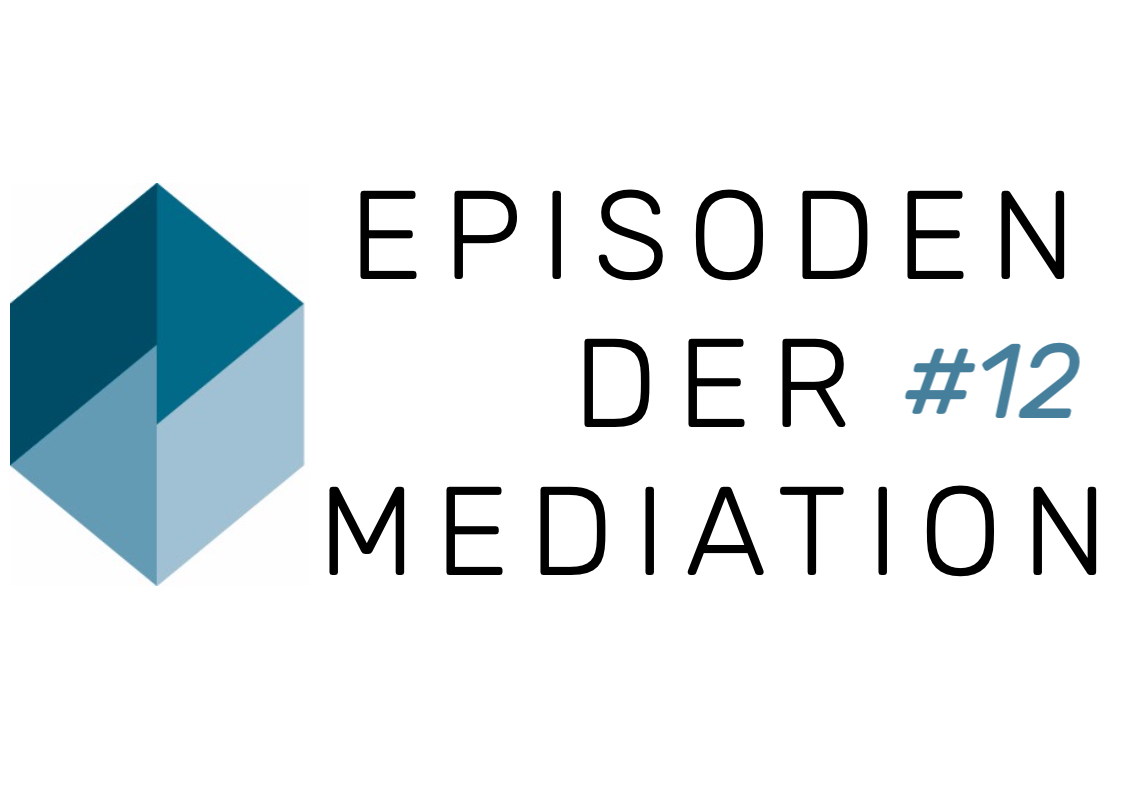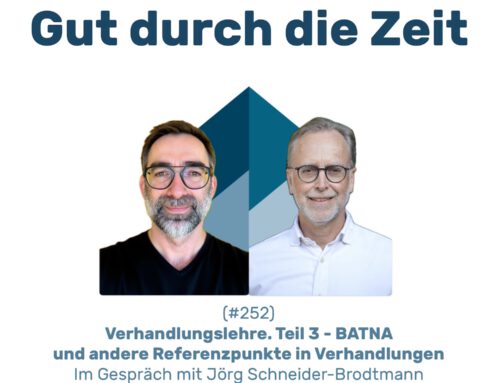INKOVEMA Podcast „Episodes of Mediation“
#12 EdM – There are no conflicts, there are only one-sided, ineffectual attempts at solutions
As if conflicts were between the conflicting parties and could be explored and dealt with by them
Episodes of mediation. The podcast on practical questions about mediation and conflict management.
Introduction: Conflict excerpts and topics
- Get lost! Leave me in peace!
- I've had enough! I'm leaving, I'm not going to listen to this any longer!
- That's it, you can't just call the customer, I demand that you inform me beforehand.
- I don't have a conflict with you, you have a problem, but it's your problem!
- You need to talk to me more!
- Leave me alone, I don't need to talk to you at all!
Area of tension: Conflict and conflict management
What you hear here sounds like a conflict, but from a different perspective, it is actually about communicated solutions. If the other person did what was asked, the conflict would be over. And if the other person instead accepted that they did not have to be asked beforehand, this episode would also be over. Today we will be looking at this tension between conflict and conflict resolution and what the conflict actually is and where its resolution begins...MUSIC
A warm welcome! You are listening to the episodes of Mediation, INKOVEMA's podcast on the practical issues of mediation and conflict management. I am Sascha Weigel and in this podcast I explain questions from mediation and conflict counselling practice, present concepts and models of mediation and classify different perspectives and decision-making options. This is Episode 12: "There are no conflicts, there are only one-sided, unsuitable attempts at solutions.
Traditional, romanticised view of conflicts
Not only in everyday life, but also in academic debate, conflicts are imagined as a separate entity that almost has a life of its own. Conflicts are modelled as something that stands between the parties, sometimes as an impenetrable undergrowth of psychology and the unfathomable, sometimes as an iceberg that has slipped between the parties and sometimes as sand in the relationship gears. However, conflicts that arise between the parties are always something that needs to be explored, analysed and illuminated, the surface of which needs to be looked beneath and the roots of which need to be addressed. The mental image always portrays conflict as a flaw that has developed between the parties involved and, like sand in the relationship gears, disrupts harmonious coexistence or productive cooperation between people. This image is traditional and, as I have indicated, is reflected in our language and way of thinking about conflict.
This idea of conflict as a flaw to be illuminated, understood and dealt with, which develops a life of its own, is a romantic conception of conflict. Romantic not because the conflict is romanticised, but because the conflict that stands between the human parties supports a romantic image, namely that without this conflict the parties could go towards their happiness and true destiny in harmony and contentment.
The fact is, conflicts consist of completely different problems that are linked to each other by the problem carriers in such a way that their solution idea has to do with the conflict party
But the fact is that conflicts cannot be perceived uniformly by the conflict parties. Their subjective involvement and localisation preclude this. At best, the parties can give up their respective and contrary perceptions, descriptions and attempts to solve the problem and engage in a joint perception, description and solution of the problem, which would abandon the previous picture.
Conflict situations are characterised by the fact that two parties have conflicting perceptions and descriptions of the problem and try to communicate their approaches to solving the problem, even against the will of the other party if necessary. These two opposing problem definitions clash and make the parties involved experience and appear separate from a common problem and solution idea. It is an important difference for the practice of conflict management whether one revitalises the linguistic image that both parties are working on a common conflict that has arisen between them and expresses this in language or whether, for example, as a mediator one speaks of two different problems, each of which belongs to different problem bearers who are of the opinion that the other is needed to solve these problems. In this episode, I would like to argue in favour of this second language and its practical consequences. It helps to maintain an empathetic distance in mediations and to resist the temptation to believe that you yourself have the better solution to the conflict, of which you no longer need to form a picture if there is NOTHING left between the parties.
Procedure in mediation
In mediation, after a mediation agreement has been concluded and the mediation discussion in the narrower sense has finally begun, we regularly start with each side first telling their point of view. In order to avoid revitalising the linguistic image of a conflict, it is no longer worth talking about perspectives (on a conflict), but rather about problem perceptions and descriptions. At the start of mediation, it would therefore be emphasised that the parties have to get to grips with their respective problematic situations and that although there are overlaps, ultimately two different problem perceptions and problem-solving approaches are described. And on this conceptual basis, listening attentively to a conflict party is also a truly new experience.
In a conflict, two completely different personality worlds come together, which already want to fit together beforehand and still want to do so for a limited period of time and on a specific topic. Whether it is a happy relationship or a conflict relationship, in private or at work, they always and permanently express themselves in negotiation processes – and in conflict, the literally decisive conclusion no longer succeeds, instead the relationship partners try to push through their respective ideas for solutions to their very own perceptions of the problem – in conflict, if necessary without or against the express will of the other side. The quotes at the beginning of this article illustrate this in a clichéd way.
What we call conflict is therefore one-sided, unsuitable and untimely attempts at a solution, because they are expressed far too early, and the parties realise that the other party does not support them. It is therefore assumed that they must be put forward more vehemently.
But how do the parties move on from these one-sided and ineffectual attempts at solutions to joint solutions?
Irrespective of tools and individual concepts and approaches, we can generally describe a path that is also inherent in our human biology: we have two ears that we cannot close, even if we do not want to hear sounds. On the other hand, we only have one mouth that we can keep shut, even if we want to say something. It is therefore worth making use of this and first of all interrupting the staccato of our own solution approaches and listening to what problem the other side is working on, which it assumes needs us to realise it, so that we can then turn around and describe the problem or problems that we have with the other side and for the solution of which we need the other side to act or refrain from acting. This is what a mediator targets, organises and structures at the beginning of mediation and ensures that it is completed. Generally, this phase of mediation is only used to create an agenda or a thematic roadmap for the mediation; in fact, however, this is the most important situation in which the two parties perceiving the problem should take a step back with their communicated solution approaches and go into the individual description of the problem, even though they have coherent solution approaches ready! This must and is often experienced as an imposition, which can often only be endured by being able to "convince" an independent person that one's own point of view is coherent and that the solution approach cannot be completely wrong – and that, with the help of the mediator, the conviction may finally succeed. This slowing down, indeed the throwing back to the problem description and the suppression of any ideas for a solution, is also a real litmus test as to whether the parties are jointly interested in a solution – and thus want to find their solution together.
The period in which both sides can jointly present their problems, which are linked to each other, and experience their often emotional swings, should create the common space in which the joint solutions are given room. This space is created, if at all, when the parties stop trying to convince each other of their solution ideas or try to push through these solution ideas and start by putting each other in the picture and allowing each other to be put in the picture.
When dealing with these clashing different problems and their unsuitable solutions by the respective parties, it is therefore initially important to suspend the search for a solution and in this sense to decelerate – because by first creating a common space that can support the solution, the solution can be found more quickly. This is what the expression means: Slow is faster.
Without this common space, it is only possible to intensify the struggle of the ricocheting of ideas for solutions or the subjugation of one side to the other.
This space is created when the two divergent individual descriptions of the problem have been successfully reduced to a common description of the problem and the parties have reorganised themselves towards each other and aligned themselves together, no longer face to face, so to speak, but looking in a common direction and continuing on a common solution path that had already begun with the mediation. The further work in mediation then corresponds more to a workshop of a working group, for example,
That'’s it for this time, thanks for listening, and maybe you were able to develop an idea or two for your case. If so, or if you just like the podcast, let me know and feel free to write to me with any questions you may still have.
If you would like to support this podcast, leave feedback on Apple Podcast.
For now, I bid you farewell with best wishesUntil next time! Get through this time well! I am Sascha Weigel
Your host from INKOVEMA – the Institute for Conflict and Negotiation Management in Leipzig and partner for professional mediation and coaching training programmes.





Leave A Comment